
Newsletter of the Shell Club of Sydney
NSW Branch, The Malacological Society of Australasia Limited ACN 067 894 848
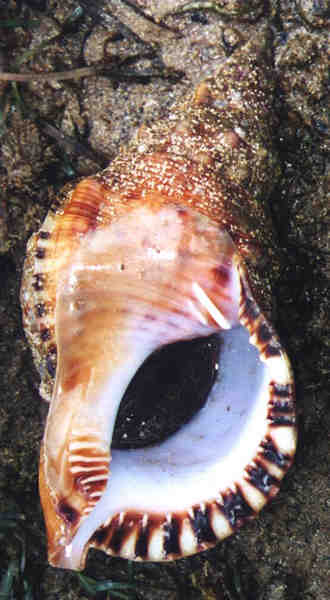
Charonia lampas rubicunda
Alive at Shark Island, Sydney Harbour
Courtesy Michael Keats
Report on a visit To Shark Island
Sydney Harbour 26/10/99
By Michael Keats, Ashley Miskelly and Stephanie Clark
As a follow up to visits on 29/6/99 (Longitudinal Study follow up), and 13/8/99 (after the 3/8/99 oil tanker discharge) a visit was made on 26/10/99 to verify the status of the mollusc fauna on the Island.
The visiting party comprised Ms Stephanie Clark and messrs Ashley Miskelly and Michael Keats. Transport arrangements were organised courtesy of the Regional Director of the National Parks & Wildlife Service, Ms Margaret Bailey. Authority to collect was covered by a scientific permit from NSW Fisheries
The conditions for fieldwork were good with a .01 tide at 1516 hours. The weather was slightly overcast with virtually no wind. There were no other people on the Island.
Intertidal collecting effort was focused on a small rocky area on the South East side of the island. This area has a number of different microhabitats, which contain a diverse array of mollusc species.
Four principal types of activity were undertaken on the day. Under water with scuba, weed washing, beach collecting and underside examination of intertidal rocks.
The findings were varied. The most disappointing were the results from the scuba examination. Ashley reported that below 3m there was little life on essentially a sandy bottom. From 3m up to the intertidal zone there was more mollusc life. A large Ranellid,
Charonia lampas rubicunda (see front cover) was observed and photographed before being returned. A single valve of the Venerid,
Antigonia chemnitzi (materna) was collected.
Five common echinoid species were observed in and below the littoral zone including the "slate pencil" sea urchin,
Phyllacanthus parvispinus Tenison-Woods, 1880, Heliocidaris erythrogramma (Valenciennes, 1846),
Heliocidaris tuberculata (Lamarck, 1816), Holopneustes purapurascens
A.Agassiz, 1972, Centrostephanus rodgersii (A.Agassiz, 1863).
Despite a healthy abundance of other intertidal sea life, the presence of only five species is not an indication of any ecological disturbance. Unlike Vauclause Bay about 2 kilometres to the South West where there are many different microhabitats and a total of 37 echinoid species found to
date, at Shark island there is only sand at depths greater than 3m. Also being an island in the middle of the harbour, there is more tidal flow and movement, a situation not favoured by sub tidal echinoid species, so species diversity is somewhat limited because of this.
It took 3 years of repeat visits with scuba to Vauclause Bay to find 37 species, compared to an hour and a half at Shark Island, and the depths using scuba at Vauclause reached 18m.
The abundance of the five intertidal species found were typical of what one would find in a non-polluted bay environment in new South Wales. In a similar environment for example at the East end of Shoal Bay on the upper central coast, the same five species exist in relative abundance.
In summary, while it was disappointing to find only five different species, it was not due to disturbances in habitat or ecological factors. Given more time and other areas around the Island to explore using scuba, there will no doubt be other echinoid species found.
Weed and algal washings are commonly very productive for molluscs, especially smaller species and among the more unusual finds was a living individual of
Proterato lachryma. This specimen was large for the species and beautifully marked.
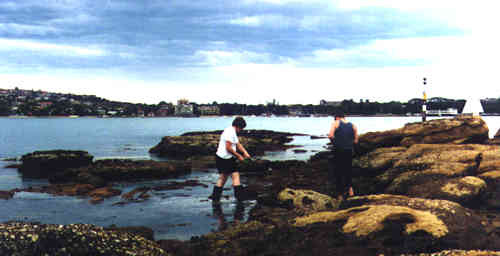
Stephanie & Ashley, weed washing
Beach collecting contained no real surprises. A fresh dead Cypraea moneta in good condition was the pick of the shell grit. A full list of the species from the visit from all areas examined is attached.
The most rewarding activity was intertidal collecting. The most dramatic find was a group of 6 specimens of
Hydatina physis, one with egg mass (picture next page). The animals were all clustered together in the shade of a large rock where they would have some protection from dehydration at very low tide. These animals were photographed. Two further live specimens were observed emerging from weed and light mud on the rising tide.
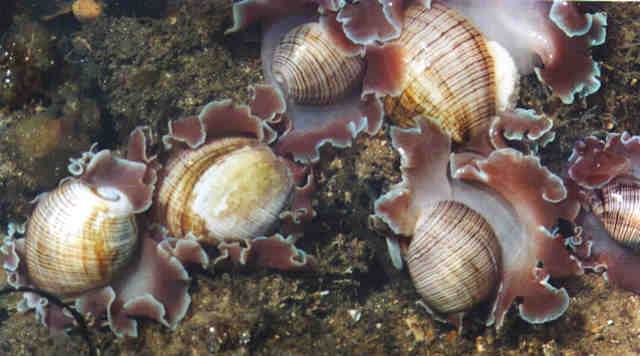
Other species photographed live included a blue ring octopus, Hapalochaena
maculosa, a brilliant red star fish, Pentagonaster dubeni, the tubinid,
Turbo imperialis, the fissurellid, Tugali
parmophoidea, the cowrie, Cypraea clandestina, and various colourful soft corals.
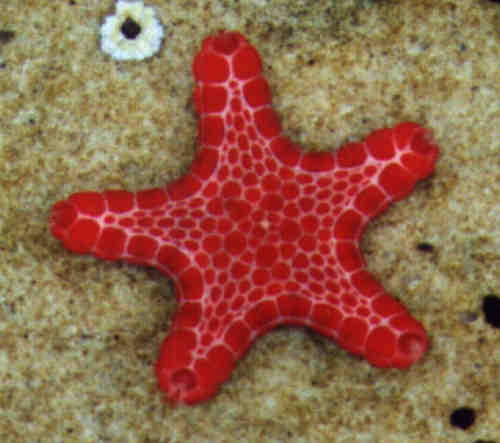
Pentagonaster dubeni
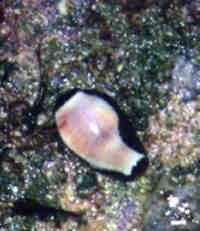
Cypraea clandestina
Notable species collected dead in the intertidal area included Strombus mutabilis, (3 specimens),
Natica gaulteriana, a single valve of Chalmys bifrons (this is probably from a picnic meal!),
Haliotis coccoradiata, (2 specimens each 53 mm), a single valve of the venerid,
Globovenus capricornia, the lucinid, Ctena bella, and the turrids
Epidera hedleyi and Paradaphane botanica
A listing of all species represented in the 26/10/99 audit is as follows. Several species of chiton were also present but not recorded.
Lottidae - Patelloida latistrigata (Angas, 1865) L
- Patelloida petterdi (Tenison Woods, 1876) L
- Patelloidea alticostata (Angas, 1865) L
- Patelloidea mufria (Hedley, 1915) L
Patellidae - Patella chapmani Tenison Woods, 1876 D
- Cellana tramoserica (Holten, 1802) L
Haliotidae - Halotis coccoradiata (Reeve, 1846) D
Neritidae - Nerita atramentosa Reeve, 1855 L
- Smaragdia souverbiana (Montrouzier, 1863) L
Skeneidae - Microarina surgerea Laseron, 1954 L
Eatonellidae - Crassitonella flammea (Frauenfeld, 1867) L
- Eatonella atropurpura (Frauenfeld, 1867) L
Cingulopsidae - Pseudopisinnia gregaria Laseron, 1950 L
Fissurellidae - Diodora lineata (Sowerby, 1835) L
- Montfortula rugosa (Quoy & Gaimard, 1834) L
- Tugali parmophoidea (Quoy & Gaimard, 1834) L
- Scutus antipodes Montfort, 1810 L
Trochidae - Herpetopoma aspersa (Phillippi, 1846) L
- Calthalotia fragum (Philippi, 1848) D
- Austrocochlea constricta (Lamarck, 1822) L
- Austrocochlea concamerata (Wood, 1828) D
- Clanculus floridus (Phillippi,1850) D
- Clanculus clangulus (Wood, 1828) L
- Stomatella imbricata (Lamarck, 1822) L
- Astele scitulum (Adams, 1854) D
- Fossarina patula (A. Adams & Angas,. 1863) L
- Phasianotrochus eximius (Perry, 1811) L
- Minolops pulcherrima (Angas, 1869) L
Turbinidae - Turbo torquatus Gmelin, 1791 D
- Turbo undulatus Lightfoot, 1786 D
- Turbo imperialis Gmelin, 1791 L
- Australium tentoriformis (Jonas, 1845) L
- Australium kesteveni (Irefdale, 1924) L
- Tricola variabilis (Pease, 1861) L
Batillaridae - Batillaria australis (Quoy & Gaimard, 1854) D/L
Cerithidae - Cacozeliana granarium (Kiener, 1842) L
- Cacozeliana icarus (Bayle, 1880) L
Dialidae - Diala sulcifera scobina (Laseron, 1950) L
Planaxidae - Hinea brasiliana (Lamarck, 1822) D
Litiopidae - Alaba opinosa (Iredale, 1936) D
- Stylifera translucida (Hedley, 1936) D
Littorinidae - Bembicium auratum (Quoy & Gaimard, 1834) L
- Bembicium nanum (Lamarck, 1822) L
- Noddilittorina unifasciata Gray, 1826) L
- Noddilittorina pyramidalis(Quoy & Gaimard1833)L
- Littorina acutispira Smith, 1892 L
Rissoidae - Alvania novarensis Frauenfeld, 1867 L
- Merelina elegans (Angas, 1877) L
Anabathronidae - Anabthron lene (Hedley, 19150 L
- Amphitalamus indicatus (Frauenfeld, 1867) L
- Pisinna sp L
Vittinellellidae - Pseudolitia micans (A. Adams, 1850) D
Strombidae - Strombus mutabilis Swainson, 1821 D
Hipponicidae - Antisabia foliacea (Quoy & Gaimard, 1835) D
Calyptraeidae - Crepidula aculeata (Gmelin, 1791) L
Cypraeidae - Cypraea clandestina Linneaus, 1758 D
- Cypraea moneta Linnaeus, 1758 D
- Cypraea caputserpentis Linnaeus, 1758 D
Triviidae - Proterato lachryma (Sowerby, 1832) L
Naticidae - Natica gaulteriana Recluz, 1844 D
Ranellidae - Cabestana spengleri Perry, 1811 L
- Charonia lampas rubicunda (Perry, 1811) L
Epitoniidae - Opalia australis(Lamarck, 1822) D
- Epitonium jukesianum Forbes, 1852 L
- Epitonium lyrum (Sowerby, 1844) D
- Epitonium delicatulum (Crosse, 1864) D
- Epitonium faba (Iredale, 1936) L
Muricidae - Chichoreus denudatus (Perry, 1811) D
- Lepsiella vinosa (Lamarck, 1822) D
- Morula marginalba Blainville, 1832 L
- Dicathais orbita (Gmelin, 1791) L
- Agnewia tritoniformis (Blainville, 1832) D
- Bedeva hanleyi (Angas, 1867) L
- Cronia aurantica (Hombron & Jacquinot, 1835) L
Buccinidae - Cominella eburnea (Reeve, 1846) L
- Engina australis (Pease, 1871) D
Nassariidae - Nassarius particeps (Hedley, 1915) D
- Nassarius pauperus (Gould, 1850) D
- Nassarius burchardi (Dunker in Phillipi, 1849) D
Collumbellidae - Pseudomycla dermestoidea (Lamarck, 1822) D
- Mitrella semiconvexa (Lamarck, 1822) D
- Pyrene scripta (Lamarck, 1822) D
- Anachhis atkinsoni (Tenison Woods, 1876) L
- Anachis fulgida (Reeve, 1859) L
Marginellidae - Cyctiscus angasi (Crosse, 1870) L
- Ovaginella ovulum (Sowerby, 1846) L
- Alaginella ochracea (Angas, 1871) L
Rissoellidae - Rissoella micra (Findlay, 1924) L
- Rissoella secunda (Iredale, 1924) L
Omalogyridae - Omalogyra liliputia (Laseron, 1954) L
Pyramidellidae - Hinemoa ligata (Angas, 1877) L
- Paracingula brazieri (Angas, 1877) D
- Pyrgulina pascoei (Angas, 1867) L
- Pyrgulina pseudalveata (Nomura, 1936) D
Runcinidae - Runcina australis Burn, 1963 L
Ilbiidae - Ilbia ilbi Burn, 1963 L
Mitridae - Mitra cooki Sowerby, 1874 D
- Mitra carbonaria Swainson, 1822 D
Turridae - Austrodrillia angasi (Crosse, 1865) D
- Epidera hedleyi (Iredale, 1931) D
- Paradaphane botanica Hedley, 1918) D
Conidae - Conus anemone Lamarck, 1810 D
Hydatinidae - Hydatina physis L
Bullidae - Bulla botanica (Hedley, 1918) D
Aplysiidae - Aplysia parvula Guilding in Moerch, 1863 L
- Aplysia synneysis Sowerby, 1869 L
Dendrodorididae - Dendrodoris denisoni (Angas, 1864) L
Siphonariidae - Siphonaria diemensis (Quoy & Gaiimard,1833) L
Nuculidae - Nucula pusilla Angas, 1877 L
Arcidae - Babatia pistachia (Lamarck, 1822) D
- Anadara trapezia (Deshayes, 1840) D
- Barbatia botanica (Hedley, 1916) L
Limidae - Lima strangei D
Pectinidae - Chlamys livida Lamarck, 1819 D
- Pecten fumata Reeve, 1852 D
- Pecten bifrons Lamarck, 1819) D
Ostreidae - Saccostrea glomerata Gould, 1850 L
Anomiidae - Anomia trigonopsis Hutton, 1877 L
Mytilidae - Trichomya hirsuita (Lamarck, 1822) D
- Mytilus galloprovincialis (Lamarck, 1819) L
- Musculus alganus Laseron, 1956 L
- Trichomusculus barbatus (Reeve, 1858) L
Malleidae - Vulsella vulsella (Linnaeus, 1758) L
Galeommatidae - Lasea australis (Lamarck, 1818) L
Neoleptonidae - Neolepton concentrica (Laseron, 1953) L
Lucinidae - Codakia rugifera (Reeve, 1835) D
- Ctena bella (Conrad, 1834) D
Veneridae - Irus crenatus Lamarck, 1818 D
- Tapes dorsatus (Lamarck, 1818) D
- Antigonia chemnitzi (Hanley, 1844) D
- Globovenus capricornia (Hedley, 1908 D
Corbulidae - Corbula stolata (Iredale, 1930) D
Mactridae - Spisula trigonella (Lamarck, 1819) D
Cleidothaeridae - Cleidorthaerus albidus (Lamarck, 1819) D
Turbinellidae
Part 16
By Ulrich Knodel
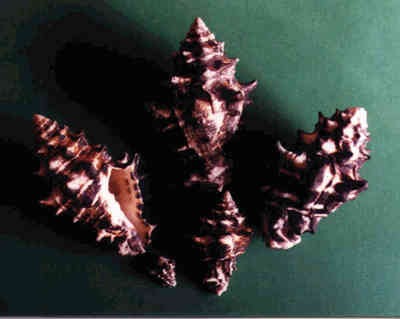
Vasum ceramicum (Linné, 1758)
as: Murex ceramicus Linné, 1758
This species is called the "Ceramic Vase" which surely base on the word "ceramic(s)" but if one likes to use common names - it is surely better to call it "Ceramian Vase" named after the type locality, Ceram Island in Indonesia. This large species is more or less common in several parts of the Indo -Pacific. It lives from Zanzibar and Madagascar to the Polynesian islands and from the Riukiu Islands to Australia.
The shell is thick and heavy, rather strongly spinose; the shape is fusiform with a high erected spire. It is black or dark brown in colour with white mottling. The several spiral cords are often at least partly white.
The size of the smaller adults is 85 - 100mm; the average size of large adults is about 100 - 120mm. Giants exist: up to 143mm (in my collection) Abbott (1959) reported about 148mm.
The habitat is well moved water on hard substrate off the front edge of coral reefs usually at a depth of 1 - 5m
( sometimes up to a depth of 10m).
Dealer Site
Hi Steve.
This is a brief message to inform you that we now have a web site, illustrating some of our specimen shells. It is
www.naturesgems.com.au
Please give my regards to the Sydney members in particular Des, Michael, Ron and David and families.
Regards
Barb Collins
Amora Shells
(Ed. The above site contains a full on line shopping cart, database - very impressive. Barb also has two physical stores in Aust.)
|






